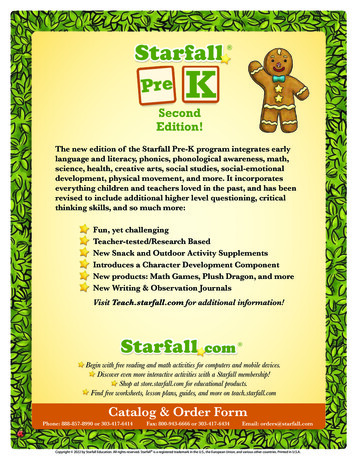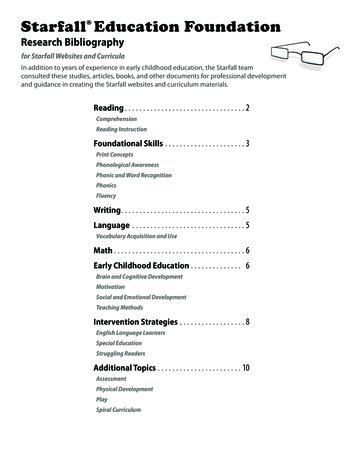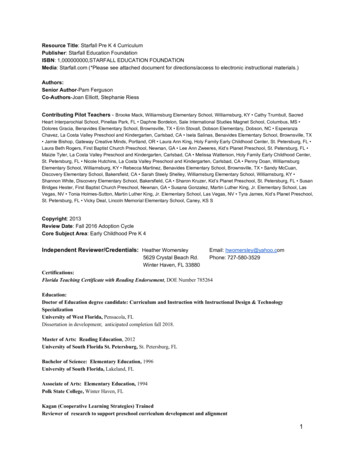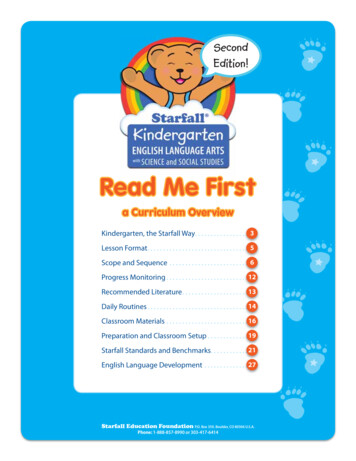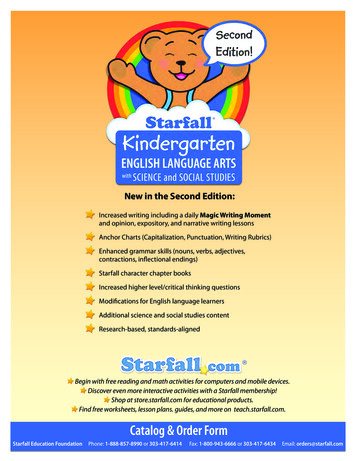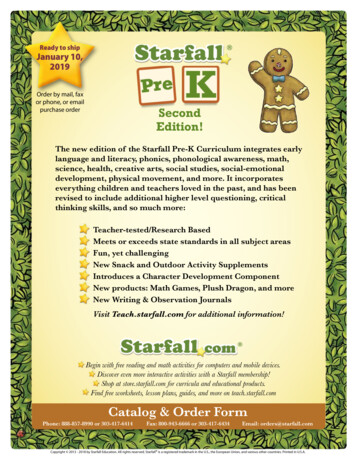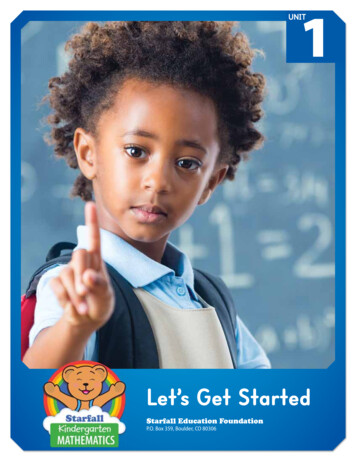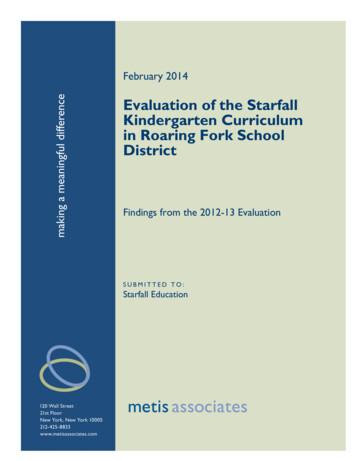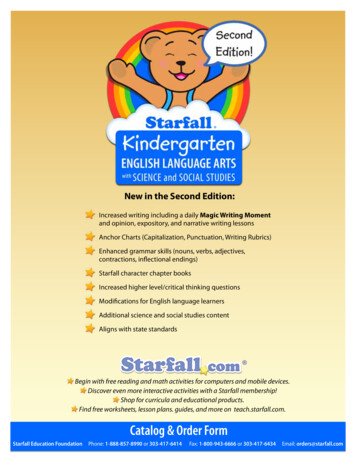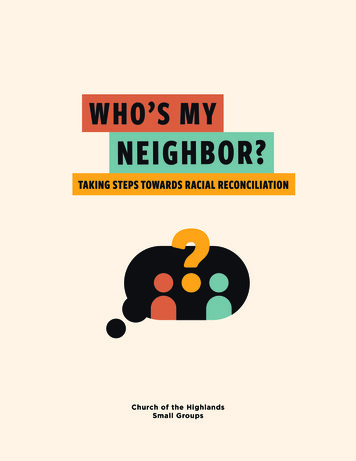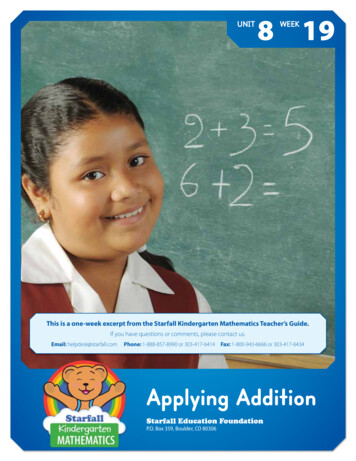
Transcription
UNIT8 19WEEKThis is a one-week excerpt from the Starfall Kindergarten Mathematics Teacher’s Guide.If you have questions or comments, please contact us.Email: helpdesk@starfall.comPhone: 1-888-857-8990 or 303-417-6414 Fax: 1-800-943-6666 or 303-417-6434Applying AdditionStarfall Education FoundationP.O. Box 359, Boulder, CO 80306
Starfall Education Foundation P.O. Box 359, Boulder, CO 80306 U.S.A.Email: helpdesk@starfall.comPhone: 1-888-857-8990 or 303-417-6414Fax: 1-800-943-6666 or 303-417-6434Copyright 2016 by Starfall Education and its licensors. All rights reserved. Starfall is a registered trademark in the US, the European Union, and various other countries. UNIT 8
UNIT8 19WEEKApplying AdditionWeek 19Summary & Preparation . . . . . . . . . . . . . . . . . . . . . . . . . . . . . . . . 370Introduction to Addition . . . . . . . . . . . . . . . . . . . . . . . . . . . . . . . . 374Using Counters and Ten-Frames. . . . . . . . . . . . . . . . . . . . . . . . . . 377Using a Number Line to Add. . . . . . . . . . . . . . . . . . . . . . . . . . . . . 379Acting It Out . . . . . . . . . . . . . . . . . . . . . . . . . . . . . . . . . . . . . . . . . . 381Learning Centers . . . . . . . . . . . . . . . . . . . . . . . . . . . . . . . . . . . . . . 384UNIT 8
UNIT 8WEEK19Week 19 SummaryThis week the children will be formally introduced to the operation of addition.They will learn to use several strategies that will serve as tools to assist them insolving addition problems.The children will also: Be introduced to the plus sign (“Plus Sign Poem”) Explore number combinations of five Learn strategies to solve number stories Create their own addition number storiesPreparationDisplay Backpack Bear’s Math Big Book, page 44, “Strategiesfor Adding” where you will be able to refer to it during thisweek’s math lessons.DAY 1Display Backpack Bear’s Math Big Book, page 43, the “PlusSign Poem” where the children may easily view it.The children will use their math mats and math bags.DAY 2Prepare each child’s math bag to include a small plastic bag of 5 double-sided coloredcounters. You will also need a small plastic or paper cup for each pair of children.DAY 3You will use Addition Equation Cards and 1 index card for each child.Note: Save the index cards after today’s lesson. You will use them again in Unit 9, Week 22.370 UNIT 8
UNIT 8DAY 4WEEK 19No additional preparation needed.DAY 5Activity Center 1 — Navigate classroom computers to Starfall.com.Activity Center 2 — The children will each need a math mat, a plasticbag of 10 double-sided, colored counters, a ten-frame, and a plastic orpaper cup.Activity Center 3 — The children will use 1 or 2 “What’s Your Answer?”game boards and a pair of dice. Each child in the center will need 20connect cubes.Activity Center 4 — Prepare materials for this week’s Teacher’sChoice Activity.Summative Assessment — The children in this group will play “A Walk in thePark.” They will use 1 or 2 “A Walk in the Park” game boards, game spinnersnumbered 1 through 5, and a playing piece for each child.To perform this week’s Summative Assessment, the children individually identify the largernumbers on dominoes and count on from those numbers. Record responses on theSummative Assessment Checklist for Unit 8, Week 19.Summative AssessmentUnit 8 - Week 19UNIT 8 371
UNIT 8WEEK19Daily RoutinesDAY 1DAY 2 Calendar Place Value Weather Hundreds Chart Number LineIntroduce “Operation”“Five Little Bears”Determine the number that isone more than anotherReview addition strategiesMagic MathMomentMath Concepts“Plus Sign” PoemIntroduction to addition andaddition strategiesFormative /SummativeAssessmentUse addition strategies to solveproblems“Shake, Spill, and Add”Create addition equations usingcolored countersAddition practiceWrite addition equations tototal 10Starfall.com: Math Songs: “FiveLittle Bears”Workbook page 9Workbooks& Media372 UNIT 8
UNIT 8WEEK 19DAY 3DAY 4 Calendar Place Value Weather Hundreds ChartDAY 5 Number LineLearning CentersCounting on using theNumber LineAddition Equation Cards andcounting onStarfall.com:1 Monthly Calendar Addition & Subtraction:“Addition Intro,” AdditionPractice, ”Addition within 10”Using the Number Line to counton from a number other thanoneReview addition strategiesUsing the Number Line to addWrite addition equationsCreate a floor number lineIllustrate number storiesSolve addition equations usingthe floor number line“Shake, Spill, and Add”2“What’s Your Answer?”3Teacher’s Choice4“A Walk in the Park”5Act out addition story problemsSolve addition number storiesWorkbook page 10Summative Assessment:Distinguish the larger numberon dominoes and count onfrom themUNIT 8 373
WEEK 19DAY1Counting & CardinalityB.4c - Each successivenumber refers toone more.Operations &Algebraic ThinkingA.1 - Represent additionand subtraction ina variety of ways.A.2 - Solve wordproblems with additionand subtractionwithin 10.MagicMath MomentIntroduce “Operation”MaterialsF NoneAsk: Who knows what it means to operate on someone?(Volunteers respond.) Right, when a doctor operates he or she works tochange someone. Volunteers may share their experiences if time permits.Continue: Today we will operate, but not on each other! Instead we willoperate on numbers. When we operate on numbers, we do something tochange those numbers.Write 22 on the board. Say: Let’s perform the operation of additionon these numbers.Add a plus sign between the twos. Continue: How will performing theoperation of addition change them? Right when we perform theoperation of addition on 2 2, they become 4. Let’s operate onother numbers.Continue with several other addition problems using the term “operation” sothe children get accustomed to hearing it.MaterialsIntroduction to Addition1 Plus Sign PoemIndicate Backpack Bear’s Math Big Book, page 43, the“Plus Sign Poem.”F Whiteboards, markersF Backpack Bear’s Math BigBook, pages 43 and 44F Math matsF Math bagsSay: Backpack Bear has been learning about the operation of addition. He evenwrote a poem to help himself learn to add. He would like to share it with us!He thinks it will help us learn to perform the operation of addition, too.2 Strategies for AddingSay: We have learned strategies for counting. What are some of the strategieswe use to help us count? Volunteers respond.Continue: Right, one strategy is to use your fingers. Another strategy is touse the number line. We can use counters or cubes to help us count. Now,Backpack Bear has some good strategies to help you add numbers.Indicate Backpack Bear’s Math Big Book, page 44, Strategies for Adding.Say: Let’s look at the different strategies Backpack Bear uses to help himperform the operation of addition.Introduce the Strategies for Adding in a way that is appropriate for your class.One suggestion is to discuss each strategy. Another suggestion is to havevolunteers identify each strategy using the pictures as clues.374 UNIT 8
3 Using Addition StrategiesUWD8191Distribute math mats, math bags, whiteboards, and markers.Write the equation: 2 3 on a whiteboard.Say: Let’s try each of these strategies to perform the operation of additionand solve the problem 2 3 what? Strategy 1 — I can use my fingers. Say: Hold up 2 fingers on one hand and3 on the other hand. How many fingers are you holding up altogether?Right, 5. Strategy 2 — I can use a ten-frame. Say: Place 2 red counters and 3 bluecounters in the ten-frame on your math mat. How many counters are onthe ten-frame in all? Right, 5. Strategy 3 — I can use counters. Say: Take 2 red connect cubes and join themto 3 blue connect cubes. How many connect cubes are there altogether?Right, 5. Strategy 4 — I can use the number line. Say: Find the 2 and put your finger onit. Now hop like a bunny 3 times. What number did you land on? Right, 5. Strategy 5 — I can use tally marks. Say: Draw 2 tally marks on yourwhiteboard. Now draw 3 more tally marks. How many tally marks arethere in all? Right, 5. Strategy 6 — I can use my head and count on. Say: Think the number 2. Nowput up 3 fingers. Start at 2 and count 3 more. What is the number? Right, 5. Strategy 7 — I can draw pictures. Say: Draw 2 circles on your whiteboard.Now draw 3 squares. How many shapes do you have in all? Right, 5. Strategy 8 — I can act it out. Say: Let’s act out a story. Two children wereplaying a game. (Choose 2 volunteers to come forward.) Three more childrenjoined them. (Choose 3 more volunteers to join the first two.) How manychildren were playing the game in all? Right, 5!Ask: What did you notice about the answer to the problem 2 3 each time?Explain: Right, no matter what addition operation strategy we used to solvethe addition problem, the answer was always the same. All of the strategieshelped us find the correct answer, 5.UNIT 8 375
UWD8191Formative AssessmentUsing Addition Strategies to Solve EquationsSay: Now you will work with a partner to solve an addition problem.You and your partner will choose one of these strategies to help you performthe operation of addition and solve it.Partner the children. Write the equation 5 2 on a whiteboard.Say: The first thing you need to do is decide which addition strategy youand your partner will use. Talk about it and raise your hand when you havechosen your strategy.The children do this. They do not need to share which strategy they chose.Continue: Use the strategy you and your partner chose to solve the problem5 2 what? Partners solve the problem and share which addition operationstrategy they used with the class.Repeat with another equation. Partners choose a different strategyto solve the problem.376 UNIT 8
MagicMath MomentMaterialsFive Little BearsF Starfall.com:Math Songs: “FiveLittle Bears”Navigate a classroom computer to Starfall.com:Math Songs: “Five Little Bears.”Before opening the link, the children look for the addition strategies they learned(counting fingers, number line, acting out).Play “Five Little Bears” and discuss what happened to the number of bears eachtime a new bear arrived.MaterialsUsing Counters andTen-FramesEssential Question: How can weuse objects to show addition?1 Review Strategies for AddingWEEK 19DAY2Operations &Algebraic ThinkingA.1 - Represent additionand subtraction ina variety of ways.A.5 - Fluently add andsubtract within 5.F Paper or plastic cup foreach set of partnersF Whiteboards, markersF Math bags with 5 doublesided colored countersF Backpack Bear’s MathBig Book, page 44F Math matsF Backpack Bear’s MathWorkbook #2, page 9Indicate Backpack Bear’s Math Big Book, page 44,Strategies for Adding.Say: Backpack Bear would like to know if you remember the differentaddition strategies.Choose volunteers to indicate a strategy on page 44 of Backpack Bear’s Math BigBook, and explain what the strategy is.2 Use Counters and Ten-Frame StrategiesGather the children in a semi-circle to demonstrate “Shake, Spill and Add.” You willneed a math mat, a cup, 5 double-sided, colored counters, a whiteboard, and a marker.Say: Today we will practice two of the addition strategies. Who can find “I can use counters” on the strategy page? Who can find “I can use a ten-frame?”Volunteers indicate these strategies on the Strategies for Adding page.Choose a volunteer to partner with you to demonstrate the “Shake, Spill and Add”activity. Then choose two new volunteers to demonstrate the activity again.The children partner (stand up, hand up, partner up). Designate which child ineach pair is partner 1 and which is partner 2. Distribute a paper or plastic cup,a math mat, a math bag containing 5 double-sided, colored counters, and anUNIT 8 377
UWD8192individual whiteboard and marker to each pair. Choose one set of partners todemonstrate the following procedure to the class.Say: Partner 1, shake your cup gently. Partner 2, spill the counters onto themath mat. Now work together to place the yellow counters on the ten-frame.Add the red counters to the ten-frame.Continue: Partner 1, count the yellow and red counters. How many are therein all? Partner 2, write the equation on your whiteboard.3 Partner Work—Addition PracticeAssign new partners to work together. The children who are partner 1 gettheir math bags and math mats and the children who are partner 2 get theirwhiteboards and markers. Distribute 1 cup to each set of partners.The partners repeat the above procedure as you provide step-by-step directions.Partners switch after each run through.Allow as much time as needed to be sure the children understand the game.Formative AssessmentDifferent Ways to Make 5Distribute Backpack Bear’s Math Workbook #2. Instruct the children to turn to page 9.Say: This time when you spill your counters you will use your yellow andred crayons to record your spill. Then use your pencil to write the equation.Let’s see how many different ways we can make 5!Note: Complete the first row together if necessary.378 UNIT 8
MagicWEEK 19Math MomentDAYMaterialsCounting On Using the Number LineF PointerSay: Look at the number line. I will use a pointer totouch a number. We will use the number line to help us count on.Point to 7 on the number line. Say: Here is 7. If we add 2 more (Demonstrate“hopping” 2 more and count, 7, 8, 9.) what number will we end on? Right, 9.Seven plus 2 more equals 9.Continue: Now, it’s your turn. Here is the number 5. What is 5 plus 2 more?A volunteer indicates 5 on the number line and “hops” 2 more.Repeat with several numbers and volunteers.3Counting & CardinalityA.2 - Count forwardfrom a given number.Operations &Algebraic ThinkingA.1 - Represent additionand subtraction ina variety of ways.MaterialsUsing a Number Lineto AddF 1 Index card per child (NOTE:Save the index numbers foruse in Unit 9, Week 22.)F Pencils, crayonsF Addition Equation Cards1 Using the Number Line to AddF Backpack Bear’s MathBig Book, page 44F PointerIndicate the Backpack Bear’s Math Big Book, page 44,Strategies for Adding.Say: Today we will use the addition strategy “I can use a number line” to helpus add. Who can find that strategy on the list? A volunteer does this.Draw a number line from 0 to 10 on the classroom whiteboard.Write 3 5 .Say: We will use the number line to count on and solve the equation.The problem starts at 3. Who can find 3 on the number line? A volunteeruses a pointer and points to 3 on the number line. Circle 3 in the equationon the whiteboard.Say: The problem tells us to add 5. Adding 5 is the same as adding 1, 5 times! 1Demonstrate:0123 14 15 16 178910Say: Let’s count to be sure we added 5. We started at 3 and added 5 more.What number did we land on? Right, 8, so 3 plus 5 equals 8.Repeat with several other equations.UNIT 8 379
UWD81932 Making a Large Number LineSay: Let’s make our own number line! Each of you will write a differentnumber on your index card. Distribute an index card to each child. The children fold the index cards in half with the fold at the top. Assign a different number beginning with zero to each child. He or she writesthat number on the bottom half of the folded index card. The children writethe number in pencil first then trace it with a crayon. (The size of your class willdetermine how many numbers will be on your number line.) Remind the children they can look at the number line to help them writetheir numbers.The children bring their index cards to an area where they can arrange the foldedindex cards in order on the floor. Make sure there is space behind the cards for thechildren to stand.The child with zero places his or her index card where you would like the numberline to begin.Each child places his or her index card in order to create a floor number line.Note: To make this activity more challenging, call children out of numerical order.Formative AssessmentUse the Floor Number Line to AddFlash and read an Addition Equation Card (Example: 5 2). A volunteer standsbehind the number 5 index card.Say: The equation says 5 2. How many “hops” should we make? Right, 2.The volunteer “mini-hops” two times and lands behind the 7.Ask: Where did we land? (7) Right, 5 plus 2 more equals 7.Repeat this activity so each child has an opportunity to be the “hopper.”380 UNIT 8
MagicMath MomentMaterialsAddition Equation Cards (Counting On)Say: Today we will use the addition strategies “I canuse my head and count on” and “I can use my fingers.”F Addition EquationCardsIndicate an Addition Equation Card (Example: 1 4 ). Ask: Who can read thisequation? A volunteer does this.Indicate the equation 4 1 and ask: Who can read this equation?A volunteer does this.Ask: Are these two equations the same or are they different? Right, thenumbers are the same but they are in a different order. If we solve bothof these equations the answer will be the same since we are adding thesame numbers. But if we want to use the strategy of counting on to solvethe equations, would it be faster to count on from 1 or to count on from4? (Volunteers respond.) Let’s try it. Solve the equations by counting on. Leadthe children to understand that is quicker to solve an addition problem bycounting on from the larger number.WEEK 19DAY4Operations &Algebraic ThinkingA.1 - Represent additionand subtraction ina variety of ways.A.2 - Solve wordproblems with additionand subtractionwithin 10.Flash other Addition Equation Cards. Ask: Which number is greater (orlarger)? Let’s put that number in our heads and count on.MaterialsActing It OutF Individual whiteboards, markersF Backpack Bear’s MathWorkbook #2, page 10F Pencil, crayonsEssential Question: What strategiescan we use to solve word problems?F Backpack Bear’s MathBig Book, page 44F Nine crayons1 Review the Strategies for AddingIndicate the Backpack Bear’s Math Big Book, page 44, Strategies for Adding.Review the strategies encouraging the children to read them with you.2 Acting Out Story ProblemsSay: Let’s use the addition strategy “I can act it out.” Who can find thatstrategy on the list? A volunteer does this.Choose two volunteers to come to the front of the classroom.UNIT 8 381
UWD8194Story #1 Listen closely to this number story. There was once a teacher who wantedthe children in her class to work with partners to draw beautiful picturestogether. The teacher gave one of the children five crayons (Do this.) The teacher gave another child four crayons. (Do this.) How many crayons did these partners have to draw their pictures withaltogether? (Volunteers respond.) Right, nine. Continue: How do you know they had nine crayons altogether?Let’s count to be sure. Count the crayons orally with the children. Did we add the crayons together or take some crayons away?Right, we added the crayons. Let’s write the equation for thisnumber story on the board. Write 5 4 9 horizontally on a whiteboard. Say: Now, you write the equation on your whiteboard.Story #2 Choose ten volunteers to come to the front of the classroom. Here is another number story. Listen closely. There were five childrenplaying with blocks. Five of the volunteers pretend to play with blocks. Five more children wanted to play with blocks so they joined in.The other five volunteers join the first group. How many children played with the blocks altogether? Right, ten.How do you know? Let’s count to be sure. Count the volunteers orallywith the children. Ask: Did we add children or take away children to solve this problem?(Volunteers respond.) Right, we added. Write the equation that matchesthis number story on your whiteboard. Hold up your whiteboards whenyou are finished.3 Create an Addition StoryVolunteers take turns to make up their own addition number stories and chooseclassmates to act them out. The other children write the matching equations ontheir whiteboards.382 UNIT 8
4 Drawing PicturesUWD8194Say: This time I will tell you a number story and we will draw pictures as we go.Create the diagram pictured here on a whiteboard.A volunteer reads the number story. Ask:How many dogs does Ben have?Right, the number story said Ben has3 dogs so I will draw 3 dogs. Do this.Ben has 3 dogs. Tim has 2 cats.How many pets do Ben and Tim have in all?Ask: How many cats does Tim have?Right, Tim has 2 cats, so I will draw 2 cats.Ask: What should we do to find out howmany pets Ben and Tim have in all?Right, we should add. Now, let’s solve theproblem. What numbers should we writein the equation? Count the dogs togetherwith the children and write 3 in the first blank.Repeat for the 2 cats.Solve it: Ask: If we add 3 plus 2, how many pets are there in all? Right, 5.Formative AssessmentSolve Number StoriesDistribute Backpack Bear’s Math Workbook #2 and instruct the children to turnto page 10. Say: Now, you will solve number stories on your own. Let’s read the firstnumber story together. A volunteer reads. Repeat the story. Continue: Now, draw a picture that will help you solve the problem in thebox. The children do this. Say: When you are ready, solve the problem and write the matching equation.Note: The children complete the other two stories independently, or you maysolve them together.UNIT 8 383
WEEK 19DAY5Learning Centers1ComputerThe children explore:MaterialsF Computers navigatedto Starfall.com Monthly calendar Addition & Subtraction: “Addition Intro”Counting & Cardinality Addition & Subtraction: “Addition Practice”B.4 - Understand therelationship betweennumbers and quantities. Addition & Subtraction: “Addition within 10”B.4a - Say numbernames in order,pairing each objectwith one number.Operations &Algebraic ThinkingA.1 - Represent additionand subtraction ina variety of ways.A.5 - Fluently add andsubtract within 5.Children may navigate to other Starfall.com math activities after they haveexplored those suggested above.2”Shake, Spill, and Add”The children shake their cups containing double-sidedcounters and “spill” them onto their math mats.They place the counters on their ten-frames,count each color, and write the correspondingequation on drawing paper. The childrenrepeat as time allows.3“What’s Your Answer?”The children take turns rolling a pair of dice, addingthe numbers together, then placing a cube on one ofthe squares that represents that number. If there are nospaces available for that number, the childdoes not place a cube on the board.MaterialsF Math mat foreach childF Double-sided counters(10 for each child)F Plastic or paper cupfor each childF Drawing paper, pencilsF Ten-framesMaterialsF 1 or 2 “What’s YourAnswer?” game boardsF 20 cubes per playerF Pair of diceThe game ends when the first playercompletely fills his or her board, or playmay continue until both players filltheir boards.4Teacher’s ChoiceReview or expand a skill from this unit according to the needs of your students.384 UNIT 8
5Summative Assessment: “A Walk in the Park”The children place their playing pieces on start.They take turns spinning the spinner and moving theirplaying pieces the corresponding number of spaces.It they land on 2 or 1, they move the correspondingnumber of additional spaces. If they land on -3, theymove back 3 spaces. The first child to get to the endwins, or play may continue until all of the childrenreach the end.MaterialsUWD8195F 1 or 2 “A Walk in thePark” game boardsF Game spinnersnumbered 1–5F Playing piece foreach childF DominoesF SummativeAssessment Checklistfor Unit 8, Week 19Assess individual children in this groupby showing dominoes and asking themto identify the larger number on each,and to count on from that number.Record results on the Unit 8, Week 19Summative Assessment Checklist.UNIT 8 385
Display Backpack Bear's Math Big Book, page 44, "Strategies for Adding" where you will be able to refer to it during this week's math lessons. DAY 1 Display Backpack Bear's Math Big Book, page 43, the "Plus Sign Poem" where the children may easily view it. The children will use their math mats and math bags. DAY 2
